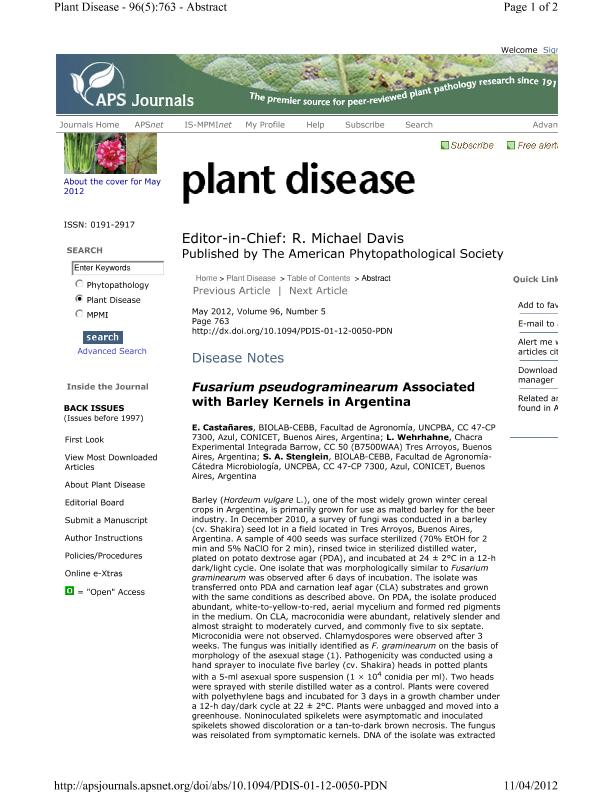Artículo
Fusarium pseudograminearum associated with barley kernels in Argentina
Fecha de publicación:
05/2012
Editorial:
American Phytopathological Society
Revista:
Plant Disease
ISSN:
0191-2917
e-ISSN:
1943-7692
Idioma:
Inglés
Tipo de recurso:
Artículo publicado
Clasificación temática:
Resumen
Barley (Hordeum vulgare L.), one of the most widely grown winter cereal crops in Argentina, is primarily grown for use as malted barley for the beer industry. In December 2010, a survey of fungi was conducted in a barley (cv. Shakira) seed lot in a field located in Tres Arroyos, Buenos Aires, Argentina. A sample of 400 seeds was surface sterilized (70% EtOH for 2 min and 5% NaClO for 2 min), rinsed twice in sterilized distilled water, plated on potato dextrose agar (PDA), and incubated at 24 ± 2°C in a 12-h dark/light cycle. One isolate that was morphologically similar to Fusarium graminearum was observed after 6 days of incubation. The isolate was transferred onto PDA and carnation leaf agar (CLA) substrates and grown with the same conditions as described above. On PDA, the isolate produced abundant, white-to-yellow-to-red, aerial mycelium and formed red pigments in the medium. On CLA, macroconidia were abundant, relatively slender and almost straight to moderately curved, and commonly five to six septate. Microconidia were not observed. Chlamydospores were observed after 3 weeks. The fungus was initially identified as F. graminearum on the basis of morphology of the asexual stage (1). Pathogenicity was conducted using a hand sprayer to inoculate five barley (cv. Shakira) heads in potted plants with a 5-ml asexual spore suspension (1 × 104 conidia per ml). Two heads were sprayed with sterile distilled water as a control. Plants were covered with polyethylene bags and incubated for 3 days in a growth chamber under a 12-h day/dark cycle at 22 ± 2°C. Plants were unbagged and moved into a greenhouse. Noninoculated spikelets were asymptomatic and inoculated spikelets showed discoloration or a tan-to-dark brown necrosis. The fungus was reisolated from symptomatic kernels. DNA of the isolate was extracted (3) and the isolate was identified to species by sequencing the reductase (RED), trichothecene 3-O-acetyltransferase (tri101), and translation elongation factor (TEF) regions (4). The sequences were compared with those in GenBank. The RED sequence (Accession No. JQ350697) showed 100% similarity, the tri101 (Accession No. JQ350698) showed 99% similarity, and the TEF (Accession No. JQ350699) showed 100% similarity with several F. pseudograminearum sequences. Additionally, the isolate was tested for the potential to produce deoxinyvalenol (DON) using a PCR approach that allows identification of two acetylated forms of DON: 15-acetyl-DON (15-ADON) and 3-ADON (2). A PCR product indicative of a 3-ADON genotype was obtained. To our knowledge, this is the first report of F. pseudograminerum associated with barley kernels in Argentina. Considering its potential to cause head blight and product mycotoxins, a large-scale survey of F. pseudograminearum on barley crops in Argentina is underway. A voucher culture (No. 1154) has been deposited in the Culture Collection of the La Plata Spegazzini Institute. References: (1) J. F. Leslie and B. A. Summerell. The Fusarium Laboratory Manual. Blackwell Publishing, Oxford, UK. 2006. (2) A. Quarta et al. Food Addit. Contam. 22:309, 2005. (3) S. A. Stenglein and P. A. Balatti. Physiol. Mol. Plant Pathol. 68:158, 2006. (4) T. J. Ward et al. Fungal Genet. Biol. 45:473, 2008.
Palabras clave:
FUSARIUM PSEUDOGRAMINEARUM
,
BARLEY
Archivos asociados
Licencia
Identificadores
Colecciones
Articulos(INBIOTEC)
Articulos de INSTITUTO DE INV. EN BIODIVERSIDAD Y BIOTECNOLOGIA
Articulos de INSTITUTO DE INV. EN BIODIVERSIDAD Y BIOTECNOLOGIA
Articulos(OCA PQUE. CENTENARIO)
Articulos de OFICINA DE COORDINACION ADMINISTRATIVA PQUE. CENTENARIO
Articulos de OFICINA DE COORDINACION ADMINISTRATIVA PQUE. CENTENARIO
Citación
Castañares, Eliana; Wehrhahne, L.; Stenglein, Sebastian Alberto; Fusarium pseudograminearum associated with barley kernels in Argentina; American Phytopathological Society; Plant Disease; 96; 5; 5-2012; 1-2
Compartir
Altmétricas




